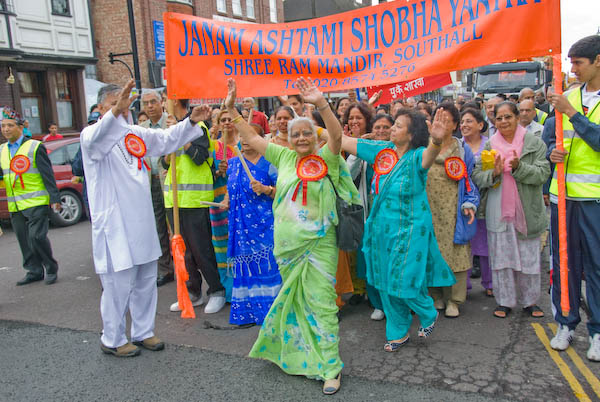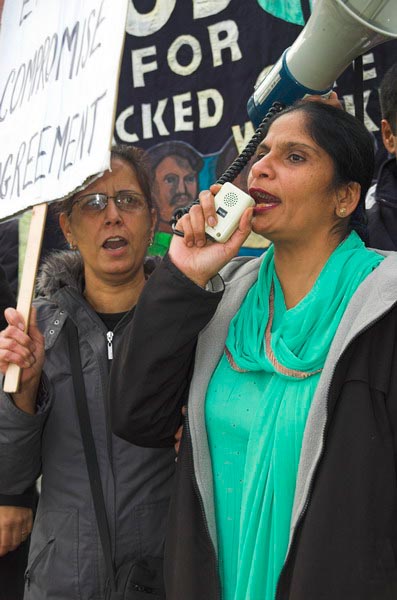October seems very much to have been a month when I’ve been concerned with justice, though it’s something at the base of much of my work in any month.

Ekta Parishad is inspired by Ghandi, here getting very wet
It started with pouring rain in London where a small group met in front of the memorial to Ghandi in Tavistock Square to show solidarity with the 100,000 people marching for land rights in India, where it was doubtless considerably hotter and drier. You can read more about the Gandhi-inspired grassroots land-rights movement Ekta Parishad and their 30 day Jan Satyagraha – March for Justice 2012 from Gwalior to Delh, which should be finishing about now in Support for March for Justice 2012 on My London Diary.

I’m not a fan of group photographs, but it was all there was to photograph
Even with an underwater camera I would have had problems. The D800E is normally quite well weather-sealed, but I’ve managed to crack the protection over the top place LCD; when I took it in to my usual repairer they told me they hadn’t yet been trained on these cameras and so it would have to go back to Nikon for repair, something I’ve not yet found time for, so I didn’t want to expose it much in this kind of weather, though I did take a few frames. The D700 too is pretty good in the wet, but the real problem is with lenses.

I thought the 16-35mm was good in the wet, and this was the lens I was mainly using, but I’d been having a problem with it for some time, with autofocus sometimes simply refusing to work. Back in the old days this would not have been a problem. I probably wrote that autofocus was unnecessary with wide-angle lenses, just something that slowed you down most of the time, and manual focus was to be preferred – if you needed to focus at all, given the depth of field.
But true as that was with older cameras such as the Olympus OM4 I was then using, it just isn’t so with modern Nikons (or I think other modern DSLRs.) The focussing screens on these modern beasts are near to useless, and if you have to use them in the near darkness of a rain storm you can more or less forget it. With the OM and other systems you could choose a focus screen that best matched the lenses you used, and with the focus aid of your choice at its centre – and usually I preferred a split image circle with a diagonal boundary with which you could focus on horizontal or vertical lines.
Modern lenses tend to have a loose focussing movement so that the motor can drive it, very different from the silky and precise action of the best older lenses – such as the Zuiko or Leica range. Unlike modern lenses they generally stayed where you put them.
Then I worked mainly with fixed focal length lenses. They all had precise and clearly marked focus scales – complete with at least some depth of field markings. With wide-angles, scale focus was often the best choice, faster than adjusting the image to be sharp on the focus screen. Zoom lenses made these trickier to implement, and coupled with the shift to autofocus cameras, focus scales have generally become, at least in the eyes of lens designers, purely vestigial.
In rain, I work with a microfibre cloth (or sometimes simply a handkerchief when I’ve mislaid the cloth) balled up in my left hand, held inside the lens hood to cover the front lens filter, wiping the filter before every image, then removing it for a brief second to zoom, frame, focus and make the exposure, hoping that no raindrops will take advantage of the time to land on the lens. Sometimes they do, though it’s usually hard to tell on the small back of the camera image, so I take several pictures to stand a good chance of getting one without areas of bleary diffusion.

But the real problem was that there really wasn’t a great deal to photograph, and we were all feeling a bit miserable in the cold rain. Several people had come ready to speak about what was happening but we all decided just to pose for a few pictures and then go to the café in the nearby Friends Meeting House for a discussion and coffee. By then both I and my cameras were too wet for me to want to take pictures.
London being as it often is, two hours later I was sweating in the sun as I walked to the bus carrying five 20×16″ framed pictures from our group show in the Hox Gallery at the Hoxton Hotel. We hope to put on A Landscape In Motion at another gallery later in the year. The 16-35 had by that time decided to come back to life though with my hands full I wasn’t taking pictures. But it didn’t have long to live.


























 Here the red light from the sun shining through the flag creates a clearly visible border across the face. But at least the position of the flag in the image makes clear why it is there. I’ve actualy made it a little less obvious by lightening the shadow area on the face.
Here the red light from the sun shining through the flag creates a clearly visible border across the face. But at least the position of the flag in the image makes clear why it is there. I’ve actualy made it a little less obvious by lightening the shadow area on the face.